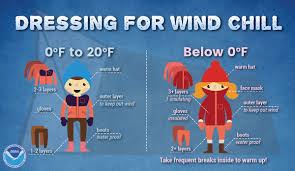The blast of winter weather has brought frigid temperatures and high winds, in other words, windchill. Unfortunately, we can’t just close the “farm” like schools or government offices during inclement weather. Livestock needs to be fed, water needs to be de-iced, equipment (might) need to be repaired and windchill is NOT our friend.
What exactly is “windchill”?
A good explanation of windchill would be, “as the wind speed increases, the body is cooled at a faster rate, causing the skin temperature to drop”. To h elp us understand the faster rate of cooling, The National Weather Service designed a windchill table to accurately calculate how cold air feels on the human skin.
elp us understand the faster rate of cooling, The National Weather Service designed a windchill table to accurately calculate how cold air feels on the human skin.
What is the windchill danger?
Windchill can lead to frostbite, which is when flesh freezes from the combination of cold temperatures and high wind. Frostbite usually starts with the fingers, toes, tip of the nose, and earlobes. Loss of feeling in these areas or if the area would turn pale or white, chances are pretty good you are experiencing frostbite. Get indoors immediately and get medical attention. Don’t forget that the lower the temperature and the higher the wind speed, the faster frostbite will occur.
Windchill can also contribute to hypothermia. Hypothermia occurs when your body’s temperature drops too low. Uncontrollable shivering, disorientation, and incoherence could signal hypothermia. Again, seek medical attention immediately.
In both cases, rewarm the body very slowly.
Do you know what to do to beat windchill?
Be sure to dress for cold weather, wear layers of loose-fitting, warm clothing – the layers will trap air and provide insulation. The outer layer s hould be water repellent and hooded. Always wear a hat, cover your mouth and protect you lungs, and remember, mittens are better than gloves.
hould be water repellent and hooded. Always wear a hat, cover your mouth and protect you lungs, and remember, mittens are better than gloves.